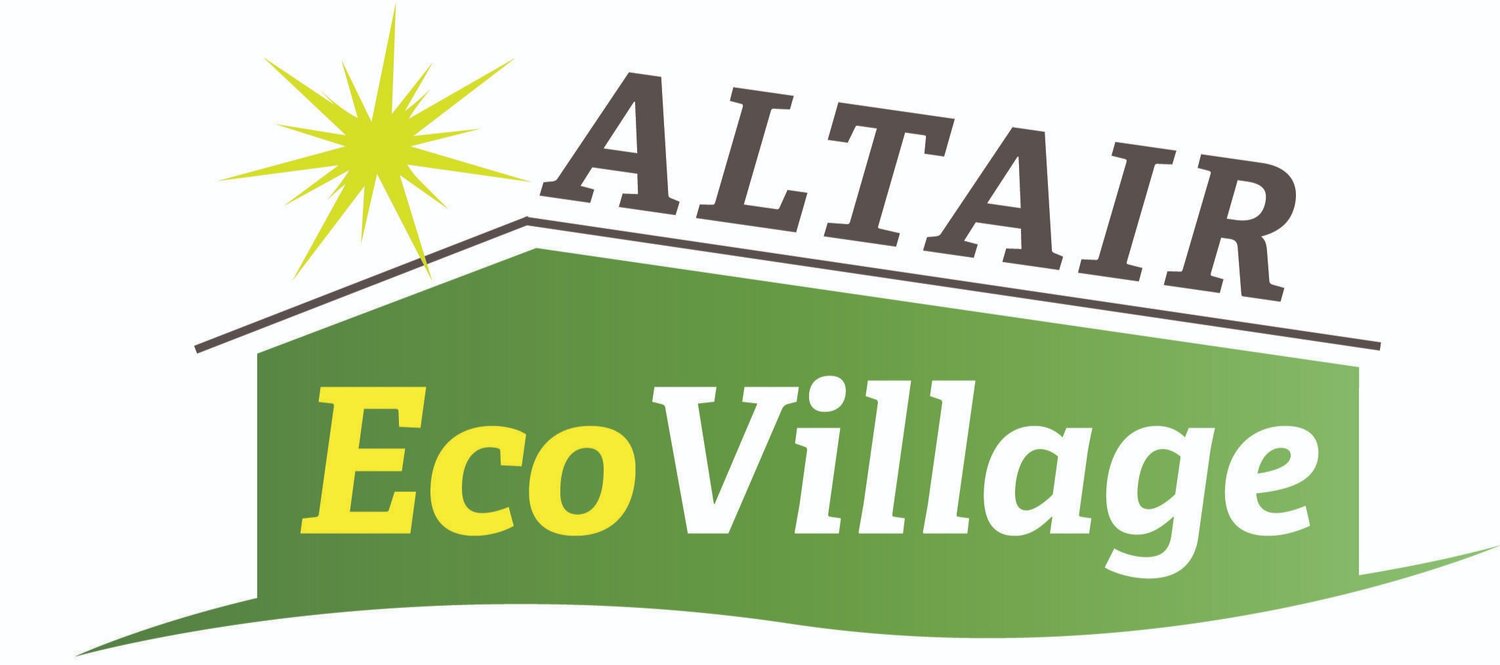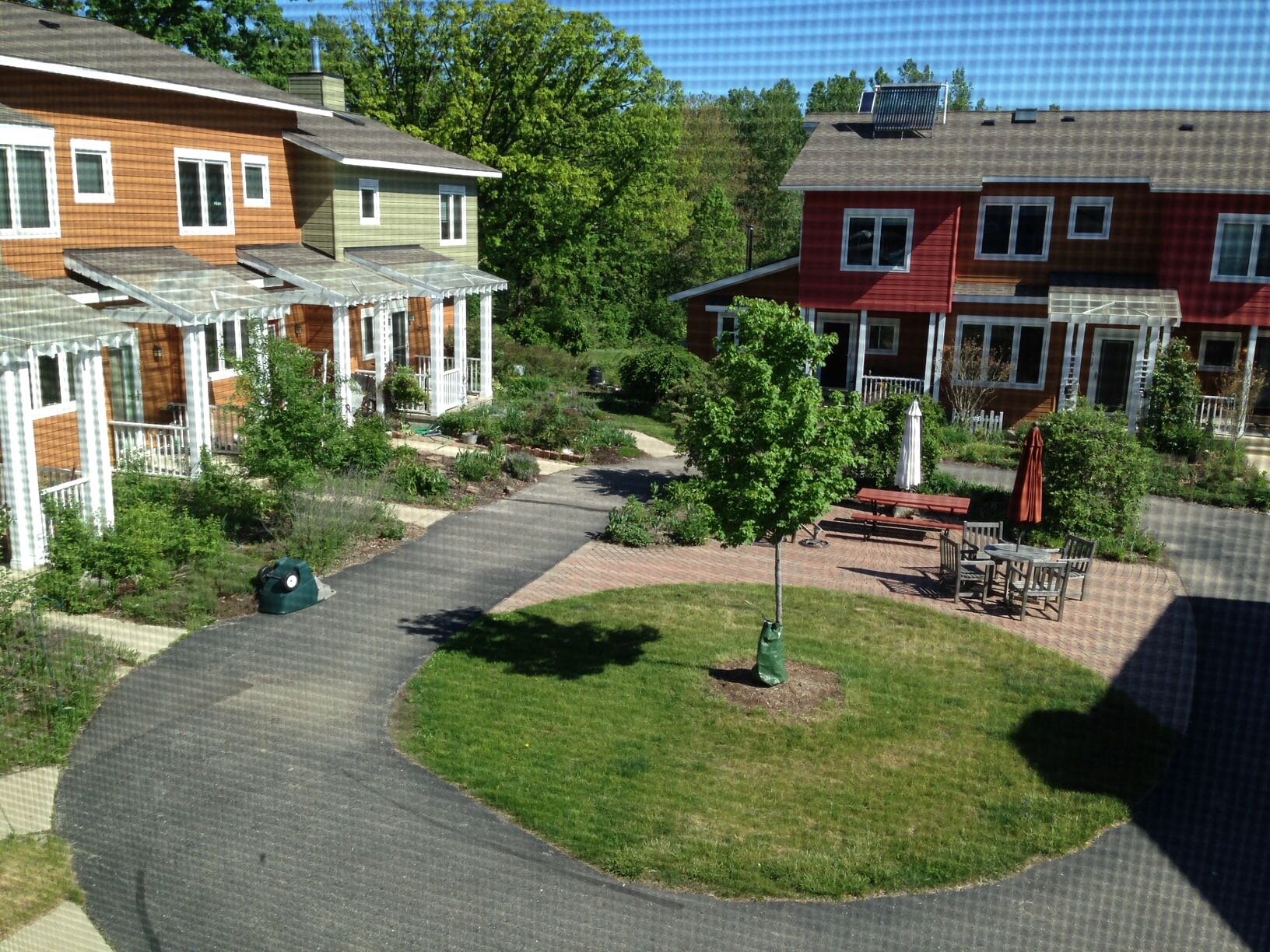Banner photo by W.L Tarbert, via Wikimedia Commons
Cohousing
within an
EcoVillage
There are many types of Ecovillages!
Ecovillages incorporate types of collaborative housing in which residents actively participate in the design and operation of their own neighborhood. Village residents are consciously committed to living as a community. Using the “Cohousing” type, the physical design encourages both social contact and individual space. In our model, private homes contain all the features of conventional homes, but residents also have access to extensive common facilities such as open space, courtyards, gardens, playgrounds, and a common house.
EcoVillages provide models for living sustainably - economically, ecologically, and with a strong social conscience. You may refer to the Global EcoVillage Network at https://ecovillage.org for a wealth of information on an international network of ecovillages. Also, go to the EcoVillages tab. Please note that for the Township Zoning Ordinance we created a very specific definition of an "EcoVillage." Altair has a non-profit entity as part of its organization to foster educating the community-at-large (as well as its members) as part of its mission, and this helps fit the definition of an EcoVillage.
The Cohousing model: Old-fashioned sense of neighborhood village communities are usually designed as attached or single-family homes along one or more pedestrian streets or clustered around a courtyard. In the U.S., they range in size from 7 to 67 residences, the majority of them housing 20 to 40 households. Regardless of the size of the community, there are many opportunities for casual meetings between neighbors, as well as for deliberate gatherings such as celebrations, clubs, and business meetings.
The Common House is the social center and "living room" of the community, with a large dining room and kitchen, lounge, recreational facilities, children’s spaces, and frequently guest rooms, workshop, and laundry room. Communities usually serve optional group meals in the Common House at least two or three times a week. The need for community members to take care of common property builds a sense of working together, trust, and support. Because neighbors hold a commitment to a relationship with one another, almost all cohousing communities use consensus as the basis for group decision-making.
Cohousing History
The model originated in Denmark in the early 1970s, when a group of people decided they did not want to live in the types of housing available to them. They felt isolated, and wanted something more resembling the neighborhoods they grew up in. When Charles Durrett and Kathryn McCamant studied the various Cohousing groups in Denmark that had struggled successfully with local governments, financial institutions, and the trend of the housing market, they decided to bring the idea back to the U.S. In 1988 they published Cohousing: A Contemporary Approach to Housing Ourselves.
Two decades later, there are over 180 Cohousing communities built across the U.S, with many more being developed. More recently, some are calling themselves “ecovillages.” Spurred by The Cohousing Association of the U.S., developers are finding that green, pre-sold, community-oriented villages are an attractive alternative to typical condos, New Urbanism, sprawling developments, and separate homes.
The basic principles of Cohousing are simple:
residents organize to plan their community,
the design promotes community interaction,
each family owns their own home, supplemented by extensive common facilities,
the residents manage the community,
the residents operate using a non-hierarchical structure, and
residents have their own income sources.
Within the framework of these basic principles, a wide variety of different communities has emerged. Some were developed almost entirely by the residents themselves, while others started when an ecovillage developer purchased land and then advertised. Village communities average around 25-35 families, with a wide range of income levels, ages, ethnic and religious backgrounds, and leadership skills. There are rural, suburban, and urban communities.
Most projects are energy-efficient, more green than neighboring projects and often have received awards for multi-family design. They are built to last; the turnover rate is exceedingly low because the members experience a richer, more fulfilling life, and many residents opt to "age in community." Hence, the property values of most Cohousing communities have increased dramatically as have the properties in the immediate neighborhood. People are willing to live in smaller homes, work with others to maintain the common property, and share resources such as guest rooms, storage, cars, and equipment because they want the interaction of community, the common meals, the celebrations, and the energy-efficient life style. As one green developer said, "Without the social component, 'green' architecture is not green!"
Where Did the Housing Model Originate?
The idea originated in Denmark, and was promoted in the U.S. by architects Kathryn McCamant and Charles Durrett in the early 1980s under their translation of the Danish concept of “living community” as "Cohousing." Worldwide, there are now hundreds of village communities, expanding from Denmark into the U.S, Canada, Australia, Sweden, New Zealand, the Netherlands, Germany, France, Belgium, Austria, and elsewhere.
In this type of community, you know who lives six houses down because you eat common meals with them, decide how to allocate homeowners dues and gratefully accept a ride from them when your car’s in the shop. You begin to trust them enough to leave your 4-year-old with them. You listen to what they have to say, even if you don’t agree with them at first, and you sense that you, too, are being heard.
Residents generally aspire to “improve the world, one neighborhood at a time.” This desire to make a difference often becomes a stated mission, as the websites of many communities demonstrate. For example, at Sunward Cohousing near Ann Arbor, MI, the goal is to create a place “where lives are simplified, the earth is respected, diversity is welcomed, children play together in safety, and living in community with neighbors comes naturally.” At Winslow Cohousing near Seattle, the aim is to have “a minimal impact on the earth and create a place in which all residents are equally valued as part of the community.” At EcoVillage at Ithaca, NY, the site of three adjoining cohousing neighborhoods, the goal is “to explore and model innovative approaches to ecological and social sustainability.” Many other communities have visions that focus specifically on the value of building community. Sonora Cohousing in Tucson, AZ, seeks “a diversity of backgrounds, ages and opinions, with our one shared value being the commitment to working out our problems and finding consensus solutions that satisfy all members.” Tierra Nueva Cohousing in Oceano, CA, exists “because each of us desires a greater sense of community, as well as strong interaction with and support from our neighbors.”

